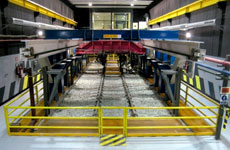
Categories
Publications
Testing railway tracks at 1:1 scale at CEDEX Track Box
28/6/2018

The paper describes the experimental facility built at CEDEX to bridge the gap between simple laboratory tests and in-situ measurements to study the mechanical behaviour of railways tracks. The texting facility, called CEDEX Track Box (CTB), is a 21 m long, 5 m wide and 4 m deep device whose main objective is to test, at 1:1 scale, complete railway track sections of conventional and high speed lines for passenger, freight and mixed traffics, at speeds up to 450 km/h. The railway track response, in terms of displacements, velocities and accelerations, is collected from a great number of linear variable differential transformers (LVDTs), geophones, accelerometers and pressure cells installed both inside the embankment and the bed layers (ballast, sub-ballast and form layer) of the track. On the other hand, the railway superstructure response is recorded with a number of mechanical displacement transducers, laser sensors, geophones and accelerometers installed on the different track superstructure components: rail, sleeper and railpad.
After checking the results obtained in CTB with in-situ measurements carried out at different points in the Spanish high speed line network, CTB has been used to research on different matters: measurement of track vertical stiffness under different track conditions by imposing static loads step by step through a set of servo-hydraulic actuators and measuring the rail deflection as a function of the load applied; calibration of 3-D numerical models under static conditions to show the crucial role played by the non-linear behaviour of the different materials constituting the track bed layers and the embankment or the trench supporting ground on the behaviour of ballasted and slab tracks; use of a commercially available machine to determine the effect of repeating tamping operations in ballast degradation; assessment of track lateral stability in CTB with the aid of a special tool that pushes away the sleeper while its horizontal movement is recorded; study of the short and the long term behaviour of railway track sections through the obtainment of ballast, subballast and form layer permanent settlement curves in fatigue tests in which, at least, one million axles were applied, under different test conditions; determination of rail deflections under the pass-by of trains at very high speeds, up to 450 km/h; optimization of bituminous subballast thickness for high speed lines under mixed traffic conditions; abatement of noise by the use of sleepers with USP.
Furthermore, CTB can be also used to: study the influence of track or ground irregularities in the behaviour of slab tracks and the corrective actions to be taken; optimize the maintenance works in slab-ballast transition zones; analyse the behaviour of curved sections; and to assess the ballast degradation in switches and crossings.Recent developments already made, such as the deployment of a 3Hz natural frequency spring system at the CTB base, will allow in the future analysing experimentally the behaviour of ballast and slab tracks founded on soft soils. A summary of some of the results obtained during the first working years are shown in this paper.
Download paper »


